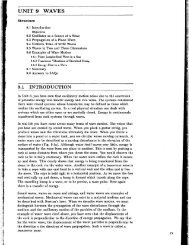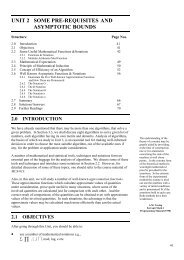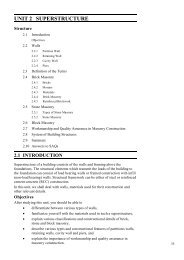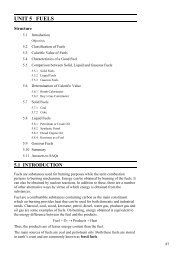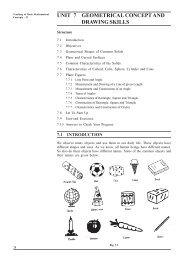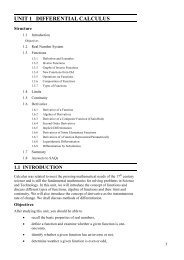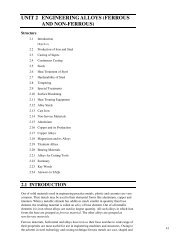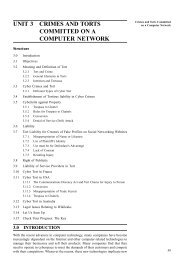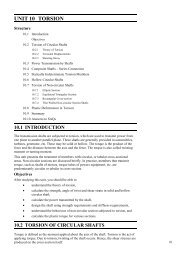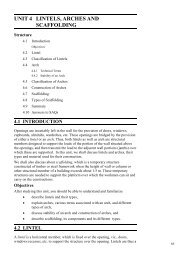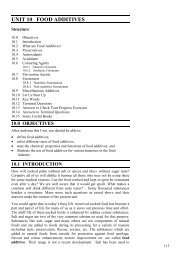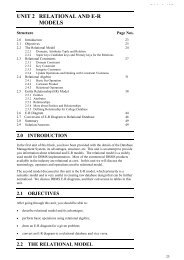unit 1 metal cutting and chip formation - IGNOU
unit 1 metal cutting and chip formation - IGNOU
unit 1 metal cutting and chip formation - IGNOU
Create successful ePaper yourself
Turn your PDF publications into a flip-book with our unique Google optimized e-Paper software.
Theory of Metal Cutting<br />
8<br />
1.3 CHIP FORMATION<br />
1.3.1 De<strong>formation</strong> in Metal Machining<br />
Figure 1.2 shows a schematic diagram of material de<strong>formation</strong> during <strong>cutting</strong>, <strong>and</strong><br />
subsequently removal of the deformed material from the workpiece by a single point<br />
<strong>cutting</strong> tool. Because of the relative motion between the tool <strong>and</strong> the workpiece, material<br />
ahead of the tool face (rake face) is compressed (elastically <strong>and</strong> then plastically). Further,<br />
movement of the tool into the workpiece deforms the work material plastically <strong>and</strong><br />
finally separates the deformed material from the workpiece. This separated material<br />
flows on the rake face of the tool called as <strong>chip</strong>. The <strong>chip</strong> near the end of the rake face is<br />
lifted away from the tool, <strong>and</strong> the resultant curvature of the <strong>chip</strong> is called <strong>chip</strong> curl.<br />
Figure 1.2 : Schematic Diagram of Chip De<strong>formation</strong><br />
The study of the mechanism of <strong>chip</strong> <strong>formation</strong> involves de<strong>formation</strong> process of the <strong>chip</strong><br />
ahead of the <strong>cutting</strong> tool. Theoretical study of the material de<strong>formation</strong> in <strong>metal</strong> <strong>cutting</strong> is<br />
difficult <strong>and</strong> therefore experimental techniques have been resorted to for analyzing the<br />
process of de<strong>formation</strong> in <strong>chip</strong>s. The methods commonly employed for this purpose are :<br />
(i) Use of movie camera for taking pictures of <strong>chip</strong>.<br />
(ii) Observing grid de<strong>formation</strong> during <strong>cutting</strong>.<br />
(iii) Examination of frozen <strong>chip</strong> samples obtained by the use of quick-stop<br />
device.<br />
Experimental study of <strong>chip</strong> de<strong>formation</strong> process has revealed that :<br />
(i) During machining of ductile materials, a plastic de<strong>formation</strong> zone is formed<br />
in front of the <strong>cutting</strong> edge (Figure 1.2).<br />
(ii) The distinctive zone of separation between the <strong>chip</strong> <strong>and</strong> workpiece where<br />
de<strong>formation</strong> gradually increases towards the <strong>cutting</strong> edge is called the<br />
primary de<strong>formation</strong>/shear zone. In shear zone extensive de<strong>formation</strong><br />
occurs. The width of shear zone is very small.<br />
(iii) The plastic de<strong>formation</strong> involved in the <strong>formation</strong> of <strong>chip</strong>s affects the<br />
hardness of material (strain hardening). Strain hardening increases when a<br />
layer undergoes de<strong>formation</strong> in the shear zone.<br />
1.3.2 Chip Types<br />
The type of <strong>chip</strong> obtained from a machining process is characterized by a number of<br />
parameters e.g., the type of tool-work engagement, work material properties <strong>and</strong> the<br />
<strong>cutting</strong> conditions.<br />
Ernst has classified the <strong>chip</strong>s obtained in machining processes into three categories :<br />
Type 1 : Discontinuous <strong>chip</strong>,




